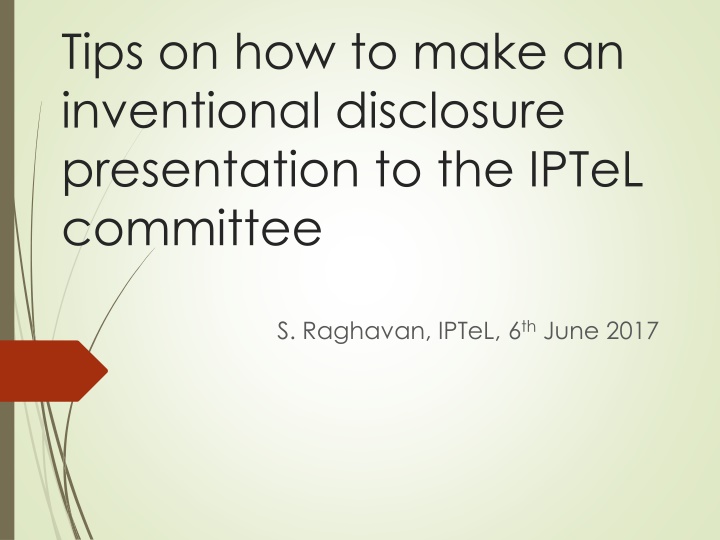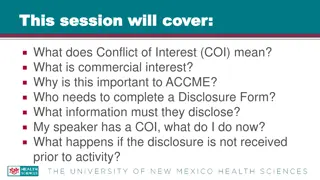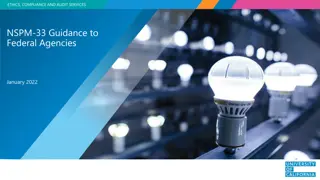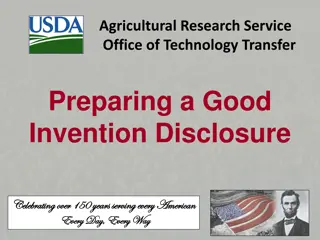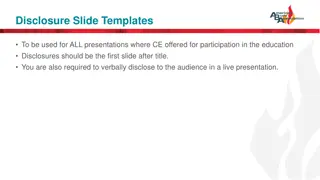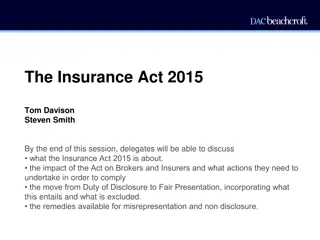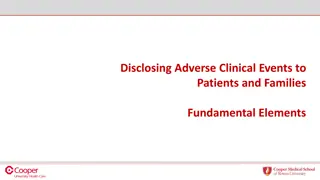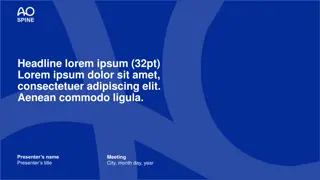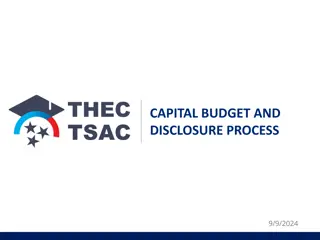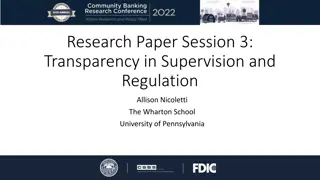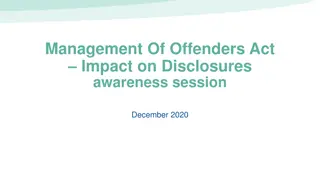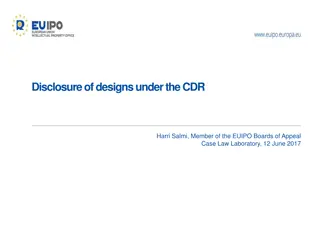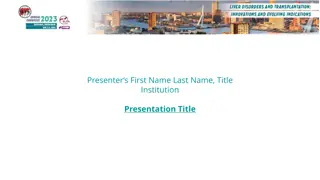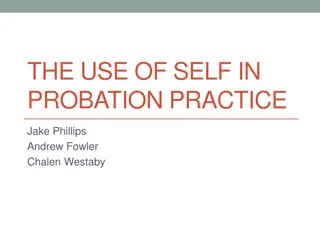Effective Inventional Disclosure Presentation Guidelines
Crafting a successful presentation to the IPTeL committee requires attention to detail and clear communication. Cover the main components of a patent disclosure like novelty, utility, and non-obviousness. Include essential details such as the title of the invention, author names, funding sources, and intellectual contributions. Present background information, describe the invention, share experimental data, and highlight the novelty and utility of your innovation. Emphasize non-obviousness over prior art, outline claims, and discuss funding agencies and industrial interests. Use visuals, orient your audience with real-life examples, and provide a brief description of your invention's workings. Follow these tips for a concise and engaging 30-minute presentation.
Download Presentation

Please find below an Image/Link to download the presentation.
The content on the website is provided AS IS for your information and personal use only. It may not be sold, licensed, or shared on other websites without obtaining consent from the author.If you encounter any issues during the download, it is possible that the publisher has removed the file from their server.
You are allowed to download the files provided on this website for personal or commercial use, subject to the condition that they are used lawfully. All files are the property of their respective owners.
The content on the website is provided AS IS for your information and personal use only. It may not be sold, licensed, or shared on other websites without obtaining consent from the author.
E N D
Presentation Transcript
Tips on how to make an inventional disclosure presentation to the IPTeL committee S. Raghavan, IPTeL, 6thJune 2017
Maximum time for presentation, including discussions and questions, is 30 minutes
The 3 main components of a patent disclosure Novelty: What is different about the invention from all that exists. Utility: What is the usefulness of the invention. Non-obviousness: How the improvement over prior art requires expertise and could not have been done by a lay person.
Title of the invention Names of all authors who have contributed intellectually with their affiliations. Names of all funding sources. Authors of a patent: Those who have contributed intellectually. Owners of a patent: Those who have funded the patent. While students and faculty members are the authors of a patent, IISc is the owner.
Contents Background Description of the invention Novelty of the invention Experimental data Utility of the invention Prior art Non-obviousness of the improvement over prior art Claims Funding agency Industrial interest (See following slides for what you should include in each of these categories)
Background Orient your audience by telling them what area of life your invention pertains to. Use pictures! A figure is worth a 1000 words. Time: 3 minutes. Example 1: We all use lighting. My invention pertains to making a novel light emitting device. Example 2: We all use cell phones. My invention pertains to making a new code that will make power consumption in cell phones more efficient. Example 3: Elderly patients need assistance for getting up from chairs. My invention involves the development of a new mechanism that will assist them in getting up. Example 4: Soldiers working in the Himalayas need clothes that can keep them warm. I have come up with a new type of fabric that is lighter and yet more thermally insulating
Description of the invention Give a quick description of how your invention works. Don t go into too many technical details at this point Keep these as back up slides in case questions arise. Time: 3 minutes Example 1: We have made a light emitting diode whose structure is as shown. It is made of a new material called Gallium Nitride. When we pass current through device in the manner shown light is emitted. Hence, it can be used as a light emitting diode Example 2: The code we have made is shown here. It works in the following way. .
Novelty - What in your invention is different from ALL that is there in the public domain papers, patents, webinformation, etc. etc. etc.- GLOBALLY. This is by far the most important part of any patent disclosure. In a CRISP fashion, describe the novelty of the invention you just described. Repeat it, even if you have included it as part of the description section. Time: 3 minutes Example 1: The structure of the light emitting diode I just described is new and have never been reported in the literature before Example 2: This portion of the code I just described is new and have never been reported in the literature before
Experimental Data Give a snapshot of data to prove that your invention indeed works. Especially concentrate on the improvement part. Keep it brief. You can have more data in your back up slides. This is not a paper. It is just to prove that your invention works. If it is a device design then you could include simulations that prove your designs work Time: 3 minutes Example 1: My code helps reduce cell phone power consumption by 10% over other comparable codes. Example 2: My LED give our 20% more light for the same power consumption.
Utility of the invention Patents are meant for commercialization, commercialization and commercialization. If you don t want to make money, don t patent it. Come up with a potential market to which your invention will cater to. Remember a patent is only valid for 20 years The novelty should therefore translate to a utility by serving an existing or impending market in this time period. Time: 3 minutes
Prior Art The IPTeL website lists sources that you can use to do prior art search (http://www.iptel.iisc.ac.in/prior-art- search) Pull out the prior art that comes closest to your inventions and list it. Time: 2 minutes
Non-obviousness The novelty you are claiming should be a non-obvious improvement over existing prior art. It is something that you should be able to justify was implemented only because of your expertise and an average lay person could not have done it. Time: 2 minutes
Claims Look up any patent to see how claims are drafted. Try and draft a set of claims that best represent your invention. This will be the starting point of your discussion with the attorney assigned by the IPTeL to work on drafting the patent. Time: 2 minutes
Funding Agency Different funding agencies have different policies. Please look into the policy and let us know if they have restrictions on ownership and licencing of IP.
Industrial Interest Please tell IPTeL of industries that have already expressed interest in your patent of could be interested in our patent. We will help you licence your IP. It is very important to sign an MOU or NDA with industries prior to discussing your research with them. Contact IPTeL for a copy of a standard agreement. Time: 1 minute
